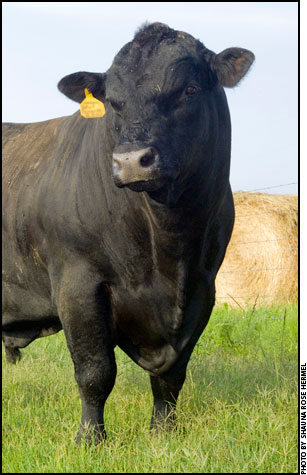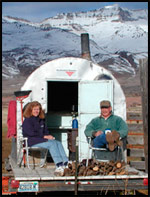MANAGEMENT...
 Proven Sires Create Top Calves, More Dollars
Proven Sires Create Top Calves, More Dollars
Proven high-accuracy bulls produce calves worth more in the feedlot. A study of Thompson Farm calves sent to a Kansas feedlot supports that conclusion. David Patterson, University of Missouri (MU) Extension beef specialist, described his study at the summer meeting of the MU Thompson Farm advisory board July 8.
Patterson and MU economists tracked the calves from conception to weaning, backgrounding, through a feedlot and to a packing plant.
Using high-accuracy sires in conjunction with fixed-time artificial insemination (AI) is creating value-added females in addition to steers that are worth more on the rail and to the consuming public, Patterson said. Read more.
Profitability Calls For Efficient Forage Production
When you look at the numbers, it's no surprise that efficient forage production has a major impact on profitability. Alan Miller, University of Illinois Extension animal specialist, tells beef producers to consider all costs when evaluating forage production's role with their enterprises.
"Our SPA (Standardized Performance Analysis) Beef Cow Business Record data indicate that 45% of total costs associated with beef cows are due to forage production costs, be it pasture or hay," he says. "When determining those costs, I encourage producers to not underestimate their land value and to be sure and include those 'hidden' start-up costs of forage production." Read more.

Ron Torell with his wife, Jackie
Cow Camp Chatter
Trailer lights
If you own an older-model ranch trailer and/or truck, chances are you share in the frustration of maintaining functional lights and brakes. You can park your trailer with the lights fully operational only to return to find they no longer work. These same lights may be working when you hook them up and drive off, but 5 miles down the road they are out again. It's enough to make you want to jump out of a basement window.
In this edition of "Cow Camp Chatter" I offer you tips from several experts I interviewed on the subject. Read more.
2010 ISBCW Coverage:
Weaning Management
Alternatives to abrupt weaning — including fenceline weaning and using a noseguard — can reduce stress and get calves off to a better start.
Joe Stookey believes the well-known
term "shipping fever" is a misnomer. The University of Saskatchewan animal behaviorist thinks it should be called "weaning fever." Addressing attendees at the International Symposium on Beef Cattle Welfare (ISBCW), Stookey said the traditional weaning process causes terrific psychological stress and prompts huge costs to the beef industry due to calf sickness and death losses.
"Weaning has to be the most traumatic and stressful event of an animal's lifetime," Stookey said. "The science is clear, showing that weaning on the ranch well before transporting calves results in improved [postweaning] health and performance. Still, most calves are weaned abruptly onto a truck headed for market."
Stookey explained how weaning calves abruptly typically results in three to five days during which calves walk the fencelines and bawl. Feed and water consumption is low, and susceptibility to infection with disease increases. Stookey said it doesn't have to be that way. Read more.
2010 ISBCW Coverage:
Beef Cattle Welfare Considerations
on Cow-Calf Operations
While cattlemen can't control some of the factors
that affect cattle well-being on the farm or ranch,
they can plan ahead.
When most people think about cow-calf operations, they visualize wide-open spaces, green grass, horse and rider and a beautiful environment. The reality is that cow-calf operations are an outdoor production system, and conditions are less than idyllic most of the year. Cattle are affected by changing weather conditions, nutrition issues and diseases.
These factors present animal welfare challenges that must be addressed at the cow-calf level, said Kansas State University (K-State) faculty members KC Olson and Chris Reinhardt as they presented to participants at the International Symposium on Beef Cattle Welfare (ISBCW) May 20. Olson is an associate professor of cow-calf nutrition and management; Reinhardt is an associate professor and Extension feedlot specialist. Read more.

Kris Ringwall
Beef Talk
Can do, must do and need to.
Agriculture is a fast-moving, high-technology business. The production and processing of agricultural products for our consumption is demanding. These demands are not getting easier as consumers increasingly become distant from production.
The connection between the cow and hamburger becomes vague and is being replaced by expectations that may or may not be real. Perhaps it is all right to ponder the why, how and consequences of our expectations. The thoughts are not age-dependent and not strange to have. They simply are what separate us as uniquely living people who care and are concerned for the rest of the world. Read more.
New Products
Industry affiliates provide a wide array of products and services to assist you on the farm and ranch. Here's an assortment of new products to hit the market recently.
• Advertising DNA-profiled cattle for sale
• Combination treatment for BRD
• Website for pasture and rangeland management news
Buy or Grow Hay?
Some producers were created to raise livestock. Other producers were created to grow hay. But Alan Miller, University of Illinois Extension animal specialist, quips not all producers were created to do both. Beef producers making the decision must take into consideration factors like feed quality, weather and nutrient flow, along with labor, cash flow and business flexibility.
"Producers who want to successfully raise hay must determine what the cost of production will be and have a clear understanding of the hay market in their area before deciding whether they are better off to buy or grow hay," Miller told attendees at the Illinois Forage Institute in March. Read more.
Angus Advisor
Click here for July herd management tips from cattle experts across the nation. Advice separated by region.
[Click here to go to the top of the page.]




